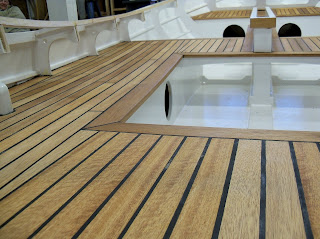The traditional way is to apply caulking to the seams, wait for it to cure, and then sand the entire deck smooth. This method sounds easy but there were some uncertainties. I have never done a laid deck before. I was concerned about caulk getting deep into the grain of the wood and then requiring excessive sanding to get it all out. This is a concern because the hull and the bulkheads limit access to sanders. I also didn't know how easy or difficult the caulking would be to sand.
The other way is to mask the deck, caulk the seams, smooth the caulk, remove the tape, and do a final finish sanding. Although there are more steps involved, I felt more comfortable with this method.
Masking
After giving the decking a thorough sanding I applied masking tape to the entire deck and everything else that I didn't want black goop on. I bought two large rolls of masking tape just in case I needed more than one roll. I nearly ran out.
Trimming
After the tape was applied, I used a single edged razor blade to trim the tape away from all the seams.
Trimming done
Apply and spread caulking
Next I pumped Sikaflex into the seams. I needed 13 tubes of caulk. It really pays to have a good caulking gun for a job of this magnitude. I had to replace my cheap gun half way through. My hand is still sore a week later.
Pulling tape
When the tape is pulled is important. I used the LOT (Long Open Time) formula of Sikaflex which takes about 5-7 days to cure. Before I caulked the boat, I made a test piece to see how the caulk behaved after each day of curing. I determined that the best time to remove the tape is 24 hours after application of the caulk. If you try to pull the tape before then, the caulk will make a mess by leaving residue on the paint. If you wait beyond 24 hours the tape will be more difficult to remove. The caulk will be be too firm and the tape will tear rather than cutting the caulk.
Sanding
My test also revealed that sanding must wait until the Sikaflex has cured for at least 4 days. Before then it is too soft. Attempting to sand it will tear out chunks of caulk from the seams.
Lumps
Lumps like this were easily sanded off after the caulk had cured for 4 days.
Finish Sanding
Sanding was not difficult and went very well. If it wasn't for the access issues with the bulkheads and hull, I think method one would have been a better way to go.
Done sanding and ready for oil
Applying Teak Oil
I have to apply 5-6 more coats of oil, but after only one coat I couldn't be more pleased with the results!


































